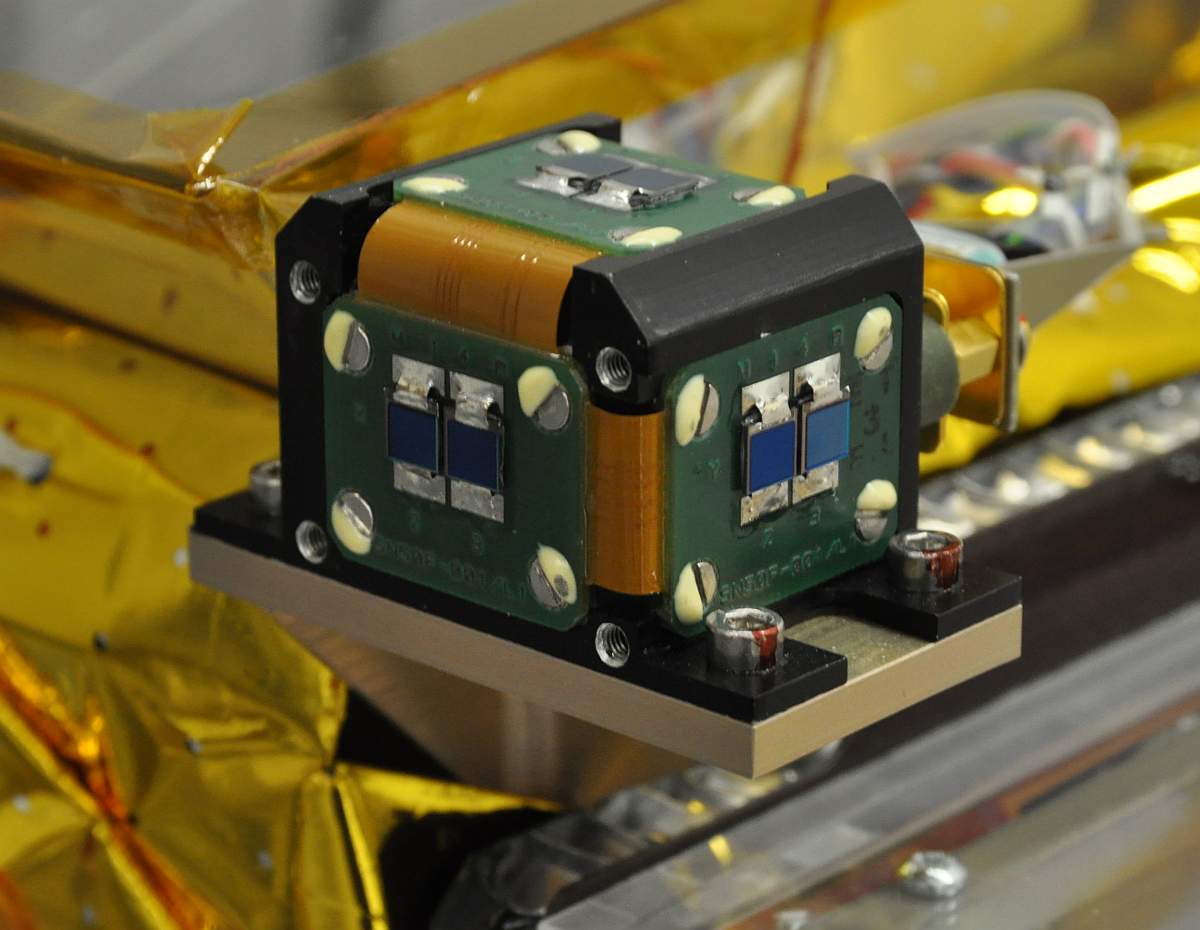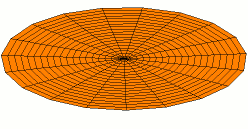 |
Sun Sensor
A Sun sensor is a navigational instrument used by spacecraft to detect the position of the Sun. Sun sensors are used for Spacecraft attitude control, attitude control, solar array pointing, gyroscope, gyro updating, and safe mode (spacecraft), fail-safe recovery. In addition to spacecraft, Sun sensors find use in ground-based weather stations and Sun-tracking systems, and aerial vehicles including Balloon (aeronautics), balloons and Unmanned aerial vehicle, UAVs. Mechanism There are various types of Sun sensors, which differ in their technology and performance characteristics. Sun presence sensors provide a binary number, binary output, indicating when the Sun is within the sensor's field of view. Analog electronics, Analog and digital electronics, digital Sun sensors, in contrast, indicate the angle of the Sun by continuous and discrete signal outputs, respectively. In typical Sun sensors, a thin slit at the top of a rectangular chamber allows a line of light to fall on an array ... [...More Info...] [...Related Items...] OR: [Wikipedia] [Google] [Baidu] |
 |
Angular Resolution
Angular resolution describes the ability of any image-forming device such as an Optical telescope, optical or radio telescope, a microscope, a camera, or an Human eye, eye, to distinguish small details of an object, thereby making it a major determinant of image resolution. It is used in optics applied to light waves, in antenna (radio), antenna theory applied to radio waves, and in acoustics applied to sound waves. The colloquial use of the term "resolution" sometimes causes confusion; when an optical system is said to have a high resolution or high angular resolution, it means that the perceived distance, or actual angular distance, between resolved neighboring objects is small. The value that quantifies this property, ''θ,'' which is given by the Rayleigh criterion, is low for a system with a high resolution. The closely related term spatial resolution refers to the precision of a measurement with respect to space, which is directly connected to angular resolution in imaging ... [...More Info...] [...Related Items...] OR: [Wikipedia] [Google] [Baidu] |
 |
Orbits
In celestial mechanics, an orbit (also known as orbital revolution) is the curved trajectory of an physical body, object such as the trajectory of a planet around a star, or of a natural satellite around a planet, or of an satellite, artificial satellite around an object or position in space such as a planet, moon, asteroid, or Lagrange point. Normally, orbit refers to a regularly repeating trajectory, although it may also refer to a non-repeating trajectory. To a close approximation, planets and satellites follow elliptic orbits, with the barycenter, center of mass being orbited at a focal point of the ellipse, as described by Kepler's laws of planetary motion. For most situations, orbital motion is adequately approximated by Newtonian mechanics, which explains Newton's law of universal gravitation, gravity as a force obeying an inverse-square law. However, Albert Einstein's general theory of relativity, which accounts for gravity as due to curvature of spacetime, with orbits ... [...More Info...] [...Related Items...] OR: [Wikipedia] [Google] [Baidu] |
 |
Astrodynamics
Orbital mechanics or astrodynamics is the application of ballistics and celestial mechanics to rockets, satellites, and other spacecraft. The motion of these objects is usually calculated from Newton's laws of motion and the Newton's law of universal gravitation, law of universal gravitation. Astrodynamics is a core discipline within space exploration, space-mission design and control. Celestial mechanics treats more broadly the orbital dynamics of systems under the influence of gravity, including both spacecraft and natural astronomical object, astronomical bodies such as star systems, planets, Natural satellite, moons, and comets. Orbital mechanics focuses on spacecraft trajectory, trajectories, including orbital maneuvers, orbital plane (astronomy), orbital plane changes, and interplanetary transfers, and is used by mission planners to predict the results of spacecraft propulsion, propulsive maneuvers. General relativity is a more exact theory than Newton's laws for calculati ... [...More Info...] [...Related Items...] OR: [Wikipedia] [Google] [Baidu] |
 |
Star Tracker
A star tracker is an optical device that measures the positions of stars using photocells or a camera. As the positions of many stars have been measured by astronomers to a high degree of accuracy, a star tracker on a satellite or spacecraft may be used to determine the orientation (or attitude) of the spacecraft with respect to the stars. In order to do this, the star tracker must obtain an image of the stars, measure their apparent position in the reference frame of the spacecraft, and identify the stars so their position can be compared with their known absolute position from a star catalog. A star tracker may include a processor to identify stars by comparing the pattern of observed stars with the known pattern of stars in the sky. History In the 1950s and early 1960s, star trackers were an important part of early long-range ballistic missiles and cruise missiles, in the era when inertial navigation systems (INS) were not sufficiently accurate for intercontinental ranges. ... [...More Info...] [...Related Items...] OR: [Wikipedia] [Google] [Baidu] |
|
Earth Sensor
Spacecraft attitude control is the process of controlling the orientation of a spacecraft (vehicle or satellite) with respect to an inertial frame of reference or another entity such as the celestial sphere, certain fields, and nearby objects, etc. Controlling vehicle attitude requires actuators to apply the torques needed to orient the vehicle to a desired attitude, and algorithms to command the actuators based on the current attitude and specification of a desired attitude. Before and during attitude control can be performed, spacecraft attitude determination must be performed, which requires sensors for absolute or relative measurement. The broader integrated field that studies the combination of sensors, actuators and algorithms is called '' guidance, navigation and control'', which also involves non-attitude concepts, such as position determination and navigation. Motivation A spacecraft's attitude must typically be stabilized and controlled for a variety of reasons. ... [...More Info...] [...Related Items...] OR: [Wikipedia] [Google] [Baidu] |
|
|
Celestial Navigation
Celestial navigation, also known as astronavigation, is the practice of position fixing using stars and other celestial bodies that enables a navigator to accurately determine their actual current physical position in space or on the surface of the Earth without relying solely on estimated positional calculations, commonly known as dead reckoning. Celestial navigation is performed without using satellite navigation or other similar modern electronic or digital positioning means. Celestial navigation uses "sights," or timed angular measurements, taken typically between a celestial body (e.g., the Sun, the Moon, a planet, or a star) and the visible horizon. Celestial navigation can also take advantage of measurements between celestial bodies without reference to the Earth's horizon, such as when the Moon and other selected bodies are used in the practice called "lunars" or the Lunar distance (navigation), lunar distance method, used for determining precise time when time is u ... [...More Info...] [...Related Items...] OR: [Wikipedia] [Google] [Baidu] |
|
|
Residual Stress
In materials science and solid mechanics, residual stresses are stresses that remain in a solid material after the original cause of the stresses has been removed. Residual stress may be desirable or undesirable. For example, laser peening imparts deep beneficial compressive residual stresses into metal components such as turbine engine fan blades, and it is used in toughened glass to allow for large, thin, crack- and scratch-resistant glass displays on smartphones. However, unintended residual stress in a designed structure may cause it to fail prematurely. Residual stresses can result from a variety of mechanisms including inelastic (plastic) deformations, temperature gradients (during thermal cycle) or structural changes ( phase transformation). Heat from welding may cause localized expansion, which is taken up during welding by either the molten metal or the placement of parts being welded. When the finished weldment cools, some areas cool and contract more than others ... [...More Info...] [...Related Items...] OR: [Wikipedia] [Google] [Baidu] |
|
 |
Vibration
Vibration () is a mechanical phenomenon whereby oscillations occur about an equilibrium point. Vibration may be deterministic if the oscillations can be characterised precisely (e.g. the periodic motion of a pendulum), or random if the oscillations can only be analysed statistically (e.g. the movement of a tire on a gravel road). Vibration can be desirable: for example, the motion of a tuning fork, the reed in a woodwind instrument or harmonica, a mobile phone, or the cone of a loudspeaker. In many cases, however, vibration is undesirable, wasting energy and creating unwanted sound. For example, the vibrational motions of engines, electric motor An electric motor is a machine that converts electrical energy into mechanical energy. Most electric motors operate through the interaction between the motor's magnetic field and electric current in a electromagnetic coil, wire winding to gene ...s, or any Machine, mechanical device in operation are typically unwanted. ... [...More Info...] [...Related Items...] OR: [Wikipedia] [Google] [Baidu] |
 |
Radiation Hardening
Radiation hardening is the process of making electronic components and circuits resistant to damage or malfunction caused by high levels of ionizing radiation (particle radiation and high-energy electromagnetic radiation), especially for environments in outer space (especially beyond low Earth orbit), around nuclear reactors and particle accelerators, or during nuclear accidents or nuclear warfare. Most Semiconductor device, semiconductor electronic components are susceptible to radiation damage, and radiation-hardened (rad-hard) components are based on their non-hardened equivalents, with some design and manufacturing variations that reduce the susceptibility to radiation damage. Due to the low demand and the extensive development and testing required to produce a radiation-tolerant design of a microelectronics, microelectronic chip, the technology of radiation-hardened chips tends to lag behind the most recent developments. They also typically cost more than their commercial cou ... [...More Info...] [...Related Items...] OR: [Wikipedia] [Google] [Baidu] |
|
Nonlinearity
In mathematics and science, a nonlinear system (or a non-linear system) is a system in which the change of the output is not proportional to the change of the input. Nonlinear problems are of interest to engineers, biologists, physicists, mathematicians, and many other scientists since most systems are inherently nonlinear in nature. Nonlinear dynamical systems, describing changes in variables over time, may appear chaotic, unpredictable, or counterintuitive, contrasting with much simpler linear systems. Typically, the behavior of a nonlinear system is described in mathematics by a nonlinear system of equations, which is a set of simultaneous equations in which the unknowns (or the unknown functions in the case of differential equations) appear as variables of a polynomial of degree higher than one or in the argument of a function which is not a polynomial of degree one. In other words, in a nonlinear system of equations, the equation(s) to be solved cannot be written as a li ... [...More Info...] [...Related Items...] OR: [Wikipedia] [Google] [Baidu] |
|
|
Volume
Volume is a measure of regions in three-dimensional space. It is often quantified numerically using SI derived units (such as the cubic metre and litre) or by various imperial or US customary units (such as the gallon, quart, cubic inch). The definition of length and height (cubed) is interrelated with volume. The volume of a container is generally understood to be the capacity of the container; i.e., the amount of fluid (gas or liquid) that the container could hold, rather than the amount of space the container itself displaces. By metonymy, the term "volume" sometimes is used to refer to the corresponding region (e.g., bounding volume). In ancient times, volume was measured using similar-shaped natural containers. Later on, standardized containers were used. Some simple three-dimensional shapes can have their volume easily calculated using arithmetic formulas. Volumes of more complicated shapes can be calculated with integral calculus if a formula exists for the shape ... [...More Info...] [...Related Items...] OR: [Wikipedia] [Google] [Baidu] |